Foreword
NOFO’s mandate is to ensure oil spill preparedness on the Norwegian continental shelf based on the companies’ oil spill response plans. For 47 years, NOFO has delivered oil spill preparedness to the operating companies.
The level of activity has been relatively high. In addition to planned activities, many exercises and check-outs have been carried out during temporary mobilization. Furthermore, there has been a continued focus on maintenance and extending the service life of oil spill response equipment, so that there is virtually no backlog of periodic maintenance.
There is a focus on cost control and financial follow-up, and reports on both finances and NOFO’s preparedness capacity are reported at board meetings.
In the second half of 2024, work began on preparing the basis for a new strategy that will apply from 2026 with a duration of 5 years +. NOFO’s tasks and organization of oil spill response will be put on the agenda, with a focus on an efficient and robust oil spill response, as well as looking at how to meet the challenges of the future.
There has been a good dialog with NOFO’s administration and the Board of Directors, and NOFO has delivered satisfactorily within the given framework and the Board’s expectations.
Forus, March 20, 2025
Hilde Ådland, Chairman of the Board
1. Executive summary
NOFO’s main activities include contingency planning and building preparedness in accordance with reported needs. This involves exercises and training of all necessary emergency response resources, base operations, logistics, procurement and maintenance of oil spill response equipment and further development of business management.
NOFO’s tasks, responsibilities and priorities follow from the strategy that covers the period 2021-2025 and is focused on the further development of effective and robust oil spill response, national cooperation and development.
NOFO shall deliver oil spill preparedness in accordance with its members’ needs at all times. In 2024, this included 94 producing fields and 42 exploration wells on the Norwegian shelf.
Emergency preparedness status is reported in a monthly KPI to the Board of Directors, which includes availability of necessary emergency preparedness materials, trained resources, emergency preparedness expertise, HSE statistics, sick leave and finances.
In 2024, the emergency response resources included an OR fleet of 27 vessels with associated oil spill response equipment, 37 ocean-going oil spill response vessels and more than 50 oil spill response vessels in coastal emergency response, in addition to extensive cooperation with state and municipal resources.
NOFO employs 49.4 full-time equivalents (FTEs), divided into 43 full-time employees and 110 employees in low position fractions related to emergency response tasks.
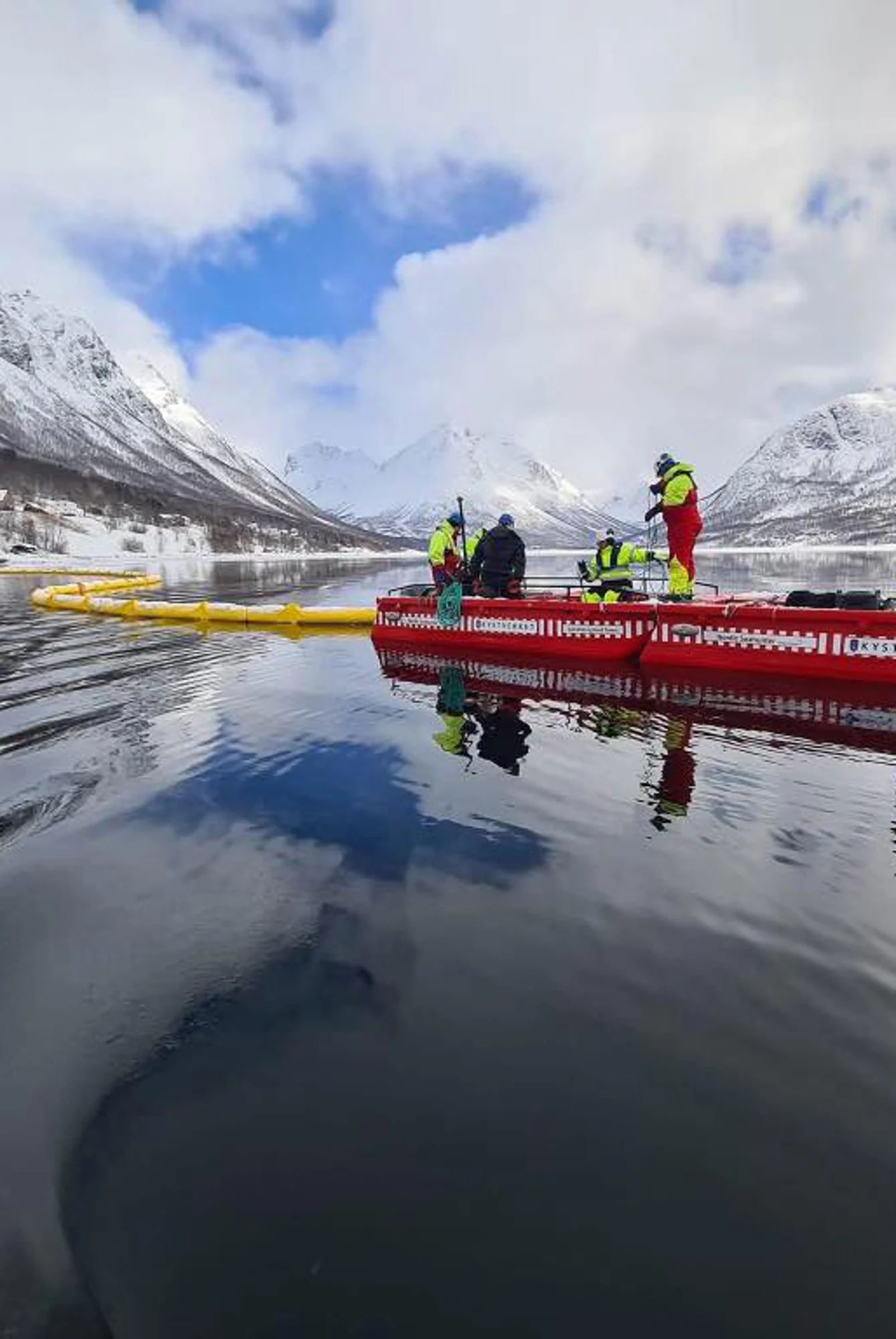
2. Governing body
2.1 Annual general meeting
Two general meetings were held in 2024.
As of 31.12.2024, NOFO has 14 members, all of which are full members.
The following operating companies are members per 31.12.2024:
AS Norske Shell, Aker BP ASA, ConocoPhillips Skandinavia AS, Harbour Energy AS, DNO Norge AS, Equinor Energy AS, OKEA ASA, OMV (Norge) AS, ORLEN Upstream Norway AS, Repsol Norge AS, Sval Energi AS, TOTAL E&P NORGE AS, Vår Energi ASA, Wellesley Petroleum AS.
2.2 NOFO's board of directors
Four ordinary board meetings were held and other board meetings were held as required.
NOFO has covered directors’ and officers’ liability insurance. As of 31.12.2024, the composition of the Board of Directors was as follows:
| Company name | Company representative | Directorships |
| Vår Energi ASA | Hilde Ådland | Chairman of the Board |
| Equinor Energy AS | Asle Jøssang | Deputy Chairman |
| Aker BP ASA | John G. Vedøy | Board member |
| Repsol Norway AS | Sara Z. Johannessen | Board member |
| OMV (Norway) AS | Åshild T. Skjærseth | Board member |
| NOFO | Jan Petter Wølstad | Employee representative |
2.3 Professional Forum
The Professional Forum is a meeting place for oil spill response discussions and exchange of experience, and is run by the operating companies.
The forum’s main objective is to help guide the community and NOFO on oil spill response topics and the direction for further work. NOFO’s general meeting, board of directors and CEO have the opportunity to ask the Professional Forum to consider individual cases and make recommendations.
In 2024, four meetings were held in the technical forum, in addition to work in several different working groups set up by the technical forum.
2.4 Maritime Forum
The Maritime Forum consists of all NOFO members who contribute OR (Oil Recovery) vessels to the NOFO pool. The working area of the forum is limited to maritime oil spill response.
Two regular annual meetings are held, and additional meetings as required. Working groups can be set up under the Maritime Forum as needed to work on specific topics within the field.
3. Organization

As of 31.12.2024, NOFO had 153 employees. These are divided into 40 employees at the office in Sandnes and 3 in Hammerfest. The remaining 110 employees are affiliated with NOFO’s emergency response groups (Watch Team, Special Team and Strand Akutt Response Group – IGSA).
The security team, IGSA and the special team together account for approximately 4.5% FTEs.
As of 31.12.2024, NOFO employs a total of 49.44 full-time equivalents (FTEs), of which 43 FTEs have NOFO as their main employer. NOFO has no hired employees as per. 31.12.2024.
NOFO is a member of the Confederation of Norwegian Enterprise (NHO) and has a collective agreement with Forbundet Styrke. In addition, a separate housing association for NOFO employees was established in 2024. The housing association is not affiliated with any union or collective agreement.
3.1 Turnover
In 2024, NOFO had a turnover rate of 4.54%. Turnover has increased slightly compared to 2023, when turnover was 2.03%. The figure does not include the emergency response teams and watch teams.
3.2 Sick leave
In 2024, NOFO had a total absence due to illness of 5%, divided between short-term absence of 1.47% and long-term absence of 3.53%.
4. Economy
NOFO’s revenue from NOFO’s members in 2024 was NOK 505.7 million, comprising NOK 452.0 million in membership fees and NOK 53.7 million in other revenue. Revenues in excess of this are compensation settlements received of NOK 16.7 million.
A profit of NOK 5.3 million is recognized in equity. The result is negatively impacted by NOK 5.2 million due to loss recognition of scrapped operating assets.
In 2024, investments in oil spill response equipment totaled NOK 83.5 million. The investments were made to upgrade equipment and to replace equipment that has reached the end of its useful life. In addition, there is a commitment for investments of NOK 40.2 million that will be delivered in 2025. The investments will be partly financed by loans of NOK 47.8 million. Other investments are financed with equity.
As a basis for decisions on investments and upgrades, NOFO draws up a long-term plan to provide predictability for investments (Strategic Investment Plan, SIP), which is revised annually in connection with the preparation of the budget.
As of 31.12.2024, NOFO’s loan obligations amounted to MNOK 268. These are loans to finance oil spill response equipment and depots. The repayment profile follows the estimated technical/economic life of the assets. The association has solid liquidity and total current assets at 31.12.24 were NOK 140.3 million.
The business is financed through membership fees and the financial risk is considered to be low. The association’s exposure to market risk, credit risk and liquidity risk is also considered to be low even though the association makes some purchases in USD, EUR and DKK. The financial statements have been prepared on a going concern basis and give a true and fair view of the business and results.
Total capital at the end of 2024 was NOK 550.1 million, and at the end of 2023 NOK 523.4 million. The equity ratio at 31.12 was 34.7% in 2024 and 35.5% in 2023.
5. NOFO’s strategy
NOFO’s current strategy is for the period 2021 to 2025 with the main goals of effective and robust oil spill response, cooperation and development, with associated specific focus areas.
In the fall of 2024, NOFO’s Board of Directors appointed a working group from NOFO’s members and NOFO’s administration to define a new strategy for NOFO for the next strategy period. Central themes from the existing strategy, such as robust and effective oil spill response and cooperation, have been further developed, while development has focused to a greater extent on NOFO’s own development needs to be best positioned for the next phase of oil activities on the Norwegian shelf.
The new strategy will be finalized during 2025.
6. Main activities for 2024
6.1 Oil spill response
On-duty personnel in NOFO’s operations management were activated on five occasions in 2024; four to assist the operator, and on one occasion to assist an Intermunicipal Committee against Acute Pollution (IUA).
Three of the incidents were based on satellite detection where NOFO contacted the operator to notify them. The other two were based on alerts from the operator and IUA, respectively, about possible oil spills.
All cases were clarified without the need for further mobilization beyond remote sensing.
6.2 Exercise - Collaboration exercise 2024
The 2024 collaboration exercise was Exercise Tveegg, and was carried out in collaboration with AkerBP, Conoco Phillips, Equinor, IUA Vestre Agder, IUA Sør-Rogaland, IUA Haugesund, the Norwegian Coastal Administration and the State Governments of Agder and Rogaland.
The common goal of the exercise was cooperation and communication between and within the various emergency response levels for handling a long-term incident. The scenario was based on an imaginary spill from drilling at Tambar in the southern North Sea, which after some time could also affect land from Lista to Karmøy.
The exercise was carried out as a staff exercise for everyone involved, except the IUAs, which had personnel in the field.
6.3 New security organization
As part of the follow-up after the contingency analysis of NOFO’s operations management, NOFO recruited and trained personnel for an adjusted on-call operations management. Extensive technical and administrative adaptations were also made to strengthen NOFO’s preparedness.
The training and co-training were carried out in intensive boot camps, and on June 3, 2024, the first shift started with an adjusted shift organization.
6.4 Contingency planning and advice
NOFO’s oil spill preparedness is dimensioned to meet the requirements of producing fields on the Norwegian shelf. NOFO provides advice to the individual operators in connection with setting up oil spill response on the individual fields with regard to the number of systems, system types, response times and capacity, etc. This forms the basis for the dimensioning of NOFO’s total oil spill preparedness, geographical and tactical distribution of oil spill response resources.
At the end of 2024, there were 94 producing fields on the Norwegian continental shelf (NCS) where NOFO provides oil spill preparedness and advice on contingency planning.
NOFO also contributes with advice and planning of oil spill preparedness for exploration wells on the Norwegian shelf. Exploration wells must be taken into account in the overall oil spill preparedness, but will often be covered by the existing oil spill preparedness in the area. In some cases, however, special preparedness measures must be established in order to comply with contingency plans that form the basis of permits.
NOFO has contributed with oil spill response advice, planning and contingency measures on 42 exploration wells during 2024.
6.5 Ocean-going fleet
NOFO’s standby fleet is a collective term for Oil Recovery (OR) vessels and Oil Spill Response vessels with which NOFO has an agreement. The emergency response fleet was trained and exercised throughout the year in accordance with the established plan.
In 2024, the OR fleet consisted of 27 OR vessels; primarily intended for a role in barriers 1 and 2:
- The standby fleet of OR vessels was 13 vessels. These are vessels that take care of area preparedness on the field with oil spill response equipment permanently placed on board in accordance with NOFO standards. These vessels engage in regular self-training to maintain their own expertise and function test the oil spill response equipment at the same time. NOFO performs verification of the vessels twice a year.
- The emergency response fleet of mobilizable OR vessels consisted of 14 vessels. These are vessels that will mobilize oil spill response equipment from the NOFO bases for emergency response or for training. All the vessels are set up to use conventional oil booms, while five of the vessels are also trained to use high-speed systems (MOS Sweeper). Thirty-seven exercises with conventional booms and five exercises with high-speed systems were carried out for the mobilizable fleet.
In addition to the OR vessels, NOFO has 37 oil spill response vessels for the ocean-going fleet (barriers 1 and 2), which are included together with the OR vessels. Of these, 25 oil spill response vessels come from the fishing fleet, 9 from the Rescue Society and 3 terminal vessels from Melkøya.
6.6 Coastal preparedness
Coastal preparedness is organized in the Coastal Response Group South (Innsatsgruppe Kyst Sør, IGK Sør), which covers the area from Måløy to Lofoten, and the Coastal Response Group North (Innsatsgruppe Kyst Nord, IGK Nord), which covers the coast north of Lofoten. In addition, NOFO has agreements with several support vessels and vessels with landing capacity.
Oil spill response vessels are mainly recruited from the fishing and aquaculture industries.
In 2024, IGK South consisted of 27 oil spill response vessels, all of which participated in one of four two-day exercises. NOFO also has access to 10 terminal vessels from Equinor and Shell that are on standby as oil spill response vessels from the operators’ onshore facilities in the area. The terminal vessels have OR class with intermediate storage capacity for oil emulsion.
In 2024, IGK Nord consisted of 26 oil spill response vessels and two support vessels. The vessels were trained through seven exercises in the region in 2024. In addition, NOFO has a contingency agreement with Equinor at Melkøya for access to terminal vessels connected to the onshore facility. NOFO, the Norwegian Coastal Administration and IUAèr in Finnmark participated in a joint interaction exercise in week 36.
6.7 Coast and beach
Innsatsgruppe Strand Akutt (IGSA) consists of 42 members who will participate in combating acute oil spills in the beach zone. The group is trained to take action to limit the damage and consequences of acute pollution. Four IGSA exercises were carried out in 2024, in Mehamn, Hasvik, Forsøl and Hammerfest respectively. Some of the exercises were collaboration exercises with IGK, the Norwegian Coastal Administration and IUA. The exercises included rapid application of granules and recording of simulated oil emulsion, use of drones and support vessels.
In 2024, NOFO’s Special Team consisted of 57 people divided between advisors, incident managers and team leaders. The team will assist in beach operations and has participants from all IUAs that NOFO has an agreement with. The team has contributed as instructors on courses at the Fire and Rescue School, in the management of IGSA on exercises, as well as in NOFO operations management and IUA during the Tveegg exercise. A joint professional gathering was held in Trondheim.
NOFO has an agreement with 21 IUAs, which are tasked with assisting with oil spill response in the coastal zone. In 2024, a full-scale exercise was carried out, skills were enhanced through courses and professional days, and participation in local and regional gatherings and activities. NOFO has been an active contributor to the revision of the curriculum and development of operational guidance for IUAs.
Through an agreement with the Fire and Rescue School, NOFO provided training in the form of basic and management courses. The ice and cold course that was conducted at the same location has developed into a good collaborative project with Oilspill Response Limited (OSRL).
6.8 NOFO bases and depots
NOFO has bases in Tananger, Sløvåg, Kristiansund, Sandnessjøen and Hammerfest. The bases are responsible for storing, maintaining, mobilizing, receiving and checking the oil spill response equipment, as well as providing personnel (oil spill response teams) for the mobilizable ocean-going fleet. During the year, a training program for oil spill response operators was completed that provides a technical and functional review of the oil spill response equipment used in an oil spill response operation.
Hydraulic equipment has been installed at several of the bases, providing a significant boost to the working environment and safety, and enabling several teams to work simultaneously on repairs, testing and preparation during an oil spill response.
NOFO has depots in Hasvik and Måsøy for equipment for coastal preparedness.
6.9 Oil spill response equipment
There has been no significant backlog of preventive maintenance during 2024.
Focusing on upgrades and life extensions of existing equipment is a continuous activity to ensure a good balance between maintenance, upgrades and new acquisitions. This includes the largest (and most expensive) oil spill response equipment, such as bilge drums and larger pumps (transrec).
New and standardized tools and washing containers are under development and two were delivered in 2024.
NOFO finds that delivery times and prices, including for oil spill response equipment, are increasing, and that suppliers have limited delivery capacity.
6.10 Remote measurement
NOFO has access to various platforms and sensors for detecting and mapping oil at sea. The various sensors and platforms have different properties and different applications. Having access to several types of tools helps us to combine them to achieve the best possible mapping of an oil spill. NOFO’s sensor carriers consist of satellite monitoring, aircraft monitoring and drones for monitoring at sea or along the coast.
On behalf of the operators, NOFO has a satellite service that covers the Norwegian continental shelf twice a day. This service is operated by KSAT. NOFO receives alerts and images of possible detections that are followed up with the operator by NOFO’s watch organization.
NOFO has a contract with SundtAir for aerial surveillance of the Norwegian shelf with LN-KYV and LN-TRG as backup aircraft, respectively. Aerial surveillance has been carried out for NOFO in connection with vessel exercises, general surveillance on the shelf, and ice surveillance in connection with exploration wells in the Barents Sea. In August 2024, LN-KYV went out of service for rebuilding and upgrading under a new contract. It is planned that it will be ready in the spring of 2025.
NOFO uses drones for local monitoring. NOFO has an agreement with Tiepoint AS and has access to 20 drones and drone pilots. Tiepoint has participated in 4 exercises with the ocean-going fleet and 13 exercises with the coastal fleet, including IGSA.
6.11 Courses and training
NOFO has significant course activities in oil spill preparedness and emergency management. As part of the training process for the new watch team organization, introductory courses were conducted in various disciplines, some of which were digital and some were conducted as classroom courses.
In total for the year, 62 courses were held with 680 participants.
The main activity was related to:
- Oil spill response courses
- Introduction course for new shifts
- ICS 300 / ICS 320 / ICS 400
7. Research and development
The focus within research and development has been to continue ongoing development processes, including:
Interim storage of emulsion in a tank
Operationalization and implementation of intermediate storage of emulsion in tanks for vessels in coastal preparedness.
Build up capacity through agreements with relevant shipowners
High Frequency (HF) drives
Collect data showing surface currents into the models for improved ocean forecasts and mapping of current conditions along the coast.
Data from the HF installations is assimilated into models such as “Norkyst”
The work is a collaboration between the Norwegian Meteorological Institute and NOFO.
Emulsion switch and effect of heating emulsions
On behalf of NOFO, Sintef has investigated the effect of using an emulsion switch and the effect of heating emulsions, as well as the combination of these.
Increased understanding of the effects of these measures will help to optimize the processes. Heating alone had little or no effect on the water content of the emulsion.
The addition of an emulsion breaker had a good effect on reducing the water content of most of the emulsions tested.
VR technology
NOFO has actively worked to use VR technology for oil spill response education and training. Here, response personnel can train to mobilize and operate oil spill response equipment according to checklists and user manuals in a virtual world without the risk of damage to either personnel or equipment.
8. Emergency preparedness
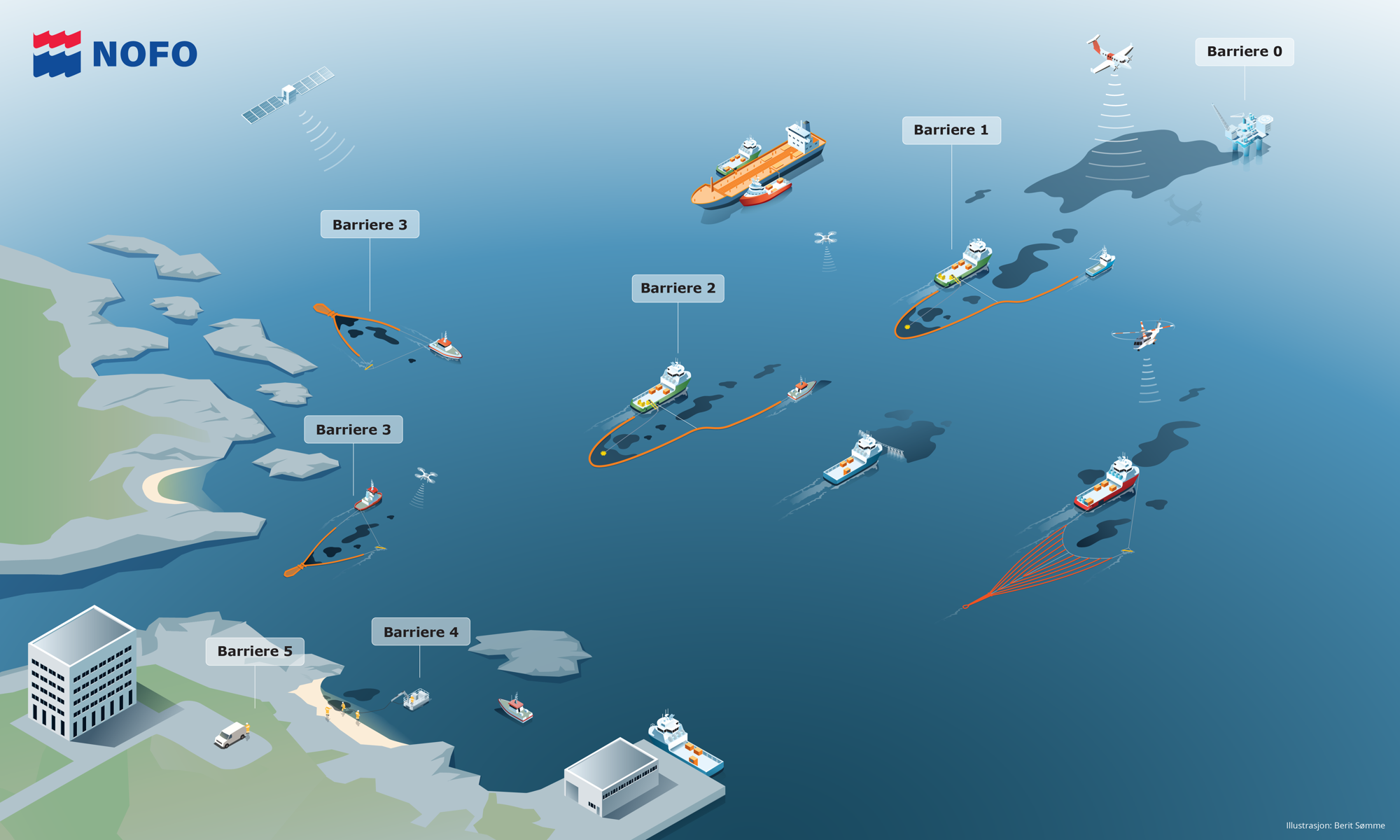
NOFO shall deliver robust and effective oil spill response dimensioned in accordance with the members’ preparedness needs. The preparedness shall be dimensioned to meet the requirements for oil spill preparedness for the producing fields and for exploration activities on the Norwegian shelf. This means that the oil spill preparedness is dimensioned to handle a major and long-term oil spill response.
Necessary oil spill response systems must be available at all times, and they must be able to be operated by vessels and crews that have the necessary expertise and training.
NOFO’s emergency response strategy is based on combating oil spills at sea as early as possible and as close to the source as possible. The response strategy is formulated as barriers from the point of discharge towards the coast and shore zone, where barriers 1 and 2 are ocean-going containment and dispersion systems, barriers 3 and 4 are containment systems used in coastal preparedness and barrier 5 is in the shore zone on land.
- In 2024, Barrier 1 and Barrier 2 mainly consisted of 30 ocean-going bilge systems divided between 13 vessels in standing readiness and 14 vessels in mobilizable readiness. This includes four high-speed systems for extra robustness.
- Barrier 3 consisted primarily of 29 high-speed systems including a fleet of more than 50 fishing and service vessels suitable for coastal operations. In addition, NOFO has access to a similar number of high-speed systems and other equipment for coastal preparedness through the Norwegian Coastal Administration.
- Barrier 4 and Barrier 5 are taken care of by resources that include IGSA, NOFO Spesialteam, IUA, the Norwegian Coastal Administration’s task forces and Novumare Ren Kyst.
- NOFO operations management supports the operators’ action management in oil spill response operations. The on-call organization is available on a one-hour response time throughout the year.
9. Corporate governance
9.1 HSE and quality
NOFO carried out its activities in 2024 without any injuries to personnel.
NOFOS’ management system covers all parts of the business, and the system is in accordance with ISO 9001:2015.
Adverse events, deviations and improvements were followed up in accordance with the management system.
NOFO continued its efforts to strengthen accident prevention safety work in a broad group of stakeholders, with a particular focus on ensuring a safe chemical working environment in the event of an oil spill response.
9.2 Risk management
Safe management of NOFO’s resources in the calendar year required active risk management of the business. The association held risk assessments in the management team, departments and in external arenas.
In collaboration with the Norwegian Coastal Administration, NOFO launched the portal Tryggaksjon.no, making knowledge about hazards and good HSE practices available to all parties involved in oil spill preparedness.
9.3 ICT security
NOFO seeks to keep abreast of threats related to ICT and has a strong focus on maintaining ICT security and data integrity. NOFO works actively to identify technical and operational improvements and measures that can further increase security related to ICT.
9.4 Communication and collaboration
NOFO’s overall communication goal is to increase knowledge and awareness of Norwegian oil spill preparedness. NOFO also works actively to strengthen cooperation between private, municipal and state actors in oil spill response in line with NOFO’s strategy.
Below are some of the activities that were carried out in 2024:
- NOFO participated in the Emergency Preparedness Day in Bodø, the event took place during the Arctic Race and was both a demonstration of preparedness capability and a platform for dialog with key players.
- NOFO had a stand at ONS 2024 where the focus was to increase knowledge about Norwegian oil spill response among visitors and stakeholders.
- NOFO was part of the program committee for the Norwegian Environment Agency’s Emergency Preparedness Forum 2024 and had several relevant, professional contributions.
- NOFO participated in “Statlig samarbeidsforum for FoU oljevern” together with the Norwegian Coastal Administration, the Norwegian Environment Agency and some of the operators. During the forum’s annual seminar, “Forum for Future Oil Spill Response 2024”, the VR project was demonstrated.
- NOFO participated actively in the project to revise the curriculum for handling acute pollution in collaboration with the Norwegian Coastal Administration and the Fire and Rescue School. Together with the Norwegian Coastal Administration, NOFO is also in the process of developing an operational guide for the IUAs.
- NOFO has collaborated with the Norwegian Coastal Administration during Exercise State Action (ØSA) in several IUAs, including preparations and implementation. NOFO was also involved in organizing the IUA management meeting.
- NOFO made several technical contributions at the International Oil Spill Conference (IOSC) in the USA.
10. Sustainability
NOFO wants to take sustainability into account throughout our operations. NOFO is not required to report, but finds that attention to sustainability is necessary and relevant regardless of reporting requirements. To ensure that NOFO delivers in line with its member companies’, the outside world’s and its own expectations and goals for sustainability, NOFO initiated a review of the sustainability area in 2024. An overarching goal is to ensure more maturity in the area of sustainability, among other things by integrating sustainability more clearly into strategy and the association’s corporate governance.
In order to improve NOFO’s maturity in the area of sustainability, NOFO has conducted a double materiality analysis based on the principles and criteria of CSRD. The analysis is based on risk management principles, with mapping of impacts, risks and opportunities.
The analysis will identify which sustainability areas NOFO has a significant impact on, and which areas have a significant impact on NOFO. This will form the basis for which areas are prioritized in the coming years.
The topics identified have been assessed based on their importance for the company’s contribution to sustainable social development and prioritized based on the expectations of our stakeholders and their importance to the association.
The status for 2024 shows that although much work remains to be done, there are several areas and topics where NOFO is already well on the way to becoming more sustainable in its activities.
The sustainability topics that were identified as material are:

Reduce our climate and environmental footprint in our own activities

Ensure a competent and good working environment

Developing a sustainable supply chain
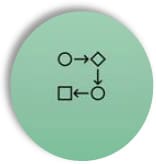
Strengthen impartiality and anti-corruption in our processes
10.1 Transparency Act – explanation
NOFO is subject to the Transparency Act and our obligations to promote fundamental human rights and decent working conditions are set out in guidelines for responsible business conduct that are anchored in the Board of Directors.
Main products/services NOFO delivers
NOFO’s main task is to meet its members’ needs for effective and robust oil spill preparedness.
General description of NOFO’s purchasing routines and due diligence
NOFO has established routines and procedures for qualification, classification and follow-up of suppliers. If violations or the risk of violations of fundamental human rights and decent working conditions are identified, appropriate measures must be implemented to stop, prevent or limit negative consequences based on the company’s affiliation, priorities and assessments. In dialogue with the supplier, NOFO will attempt to improve the identified conditions.
NOFO has a digital tool that maps the supply chain and collects information on basic human rights, decent working conditions, HSE, business ethics, the environment and supplier management.
The due diligence framework is based on the OECD Guidelines for Multinational Enterprises and the OECD Due Diligence Model for Responsible Business Conduct. This means that the investigations are based on a risk-based approach, where NOFO works systematically and efficiently to uncover which parts of its business activities are associated with the highest risk of negative impact. NOFO has initiated further investigations where the risk was assessed as unclear.
All suppliers are subject to due diligence.
The results of the due diligence identified a need for additional information from almost 9% of identified suppliers/business partners. The need for additional information was based on input materials used by the supplier/business partner, risk of human rights violations in the
supply chain or lack of information about input factors. The identified suppliers/business partners were invited to provide more detailed information.
Key suppliers and business partners
NOFO has a varied supplier base ranging from state and municipal agencies to private companies. Approximately 99% of NOFO’s suppliers and business partners are located in Norway, and NOFO has no suppliers located outside Europe.
Key products and raw materials NOFO buys
NOFO does not manufacture products for resale, and consequently no raw materials are included as input factors. NOFO purchases finished products. Most of this equipment includes steel and metals.
Actual negative consequences identified by NOFO
NOFO has not uncovered any actual violations of human rights and decent working conditions in its own operations, nor among its business partners or in the supply chain.
Significant risk of negative consequences
NOFO has not identified any first-tier suppliers or business partners where there is a significant risk of negative consequences related to fundamental human rights and decent working conditions. Nor has any such risk been identified in its own operations.
NOFO’s measures to limit the significant risk of negative consequences
NOFO requires that all suppliers and business partners conduct their business in line with internationally recognized human rights and labor rights. Furthermore, suppliers are required to conduct due diligence and implement appropriate measures for negative impacts.
NOFO’s strategy is to work on a long-term basis and have a good and open dialog with all partners.
Right to information under the Transparency Act
NOFO has published information on its website to ensure that anyone who wants information can contact the organization in writing and request information about how NOFO handles actual and potential negative consequences for fundamental human rights and decent working conditions.
Upon receipt of inquiries, NOFO has established routines to ensure that NOFO responds to the inquiry within three weeks.
In addition, NOFO has established an internal and an external whistleblowing channel for the identification of violations of the Transparency Act, and ensured that the reporting system used for non-conformities and HSE incidents also addresses any reported violations or concerns.
10.2 Report on work with equality, diversity and inclusion
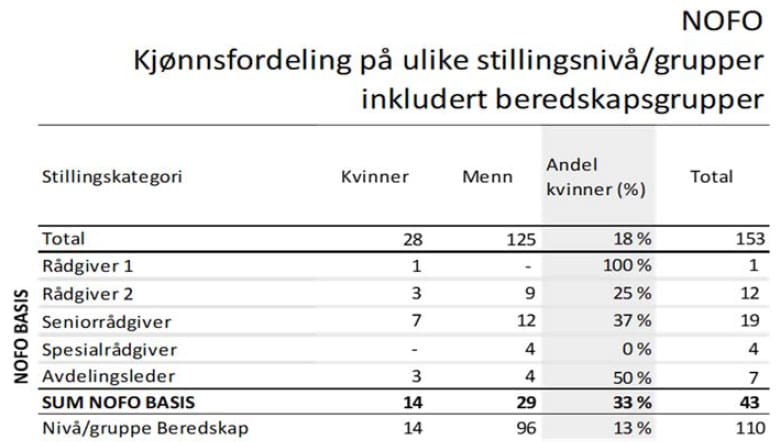
Gender equality and diversity, state of gender equality
The table shows the gender balance for NOFO employees sorted into six categories according to the position’s degree of responsibility and complexity.
Job categories 1-5 show employees in NOFO Basis. NOFO Contingency are employees in part-time positions who are affiliated with NOFO for contingency purposes. These employees preferably have a main employer other than NOFO.
Women account for 33% of NOFO Basis employees. For NOFO as a whole (including emergency response groups), the proportion of women is 18%.
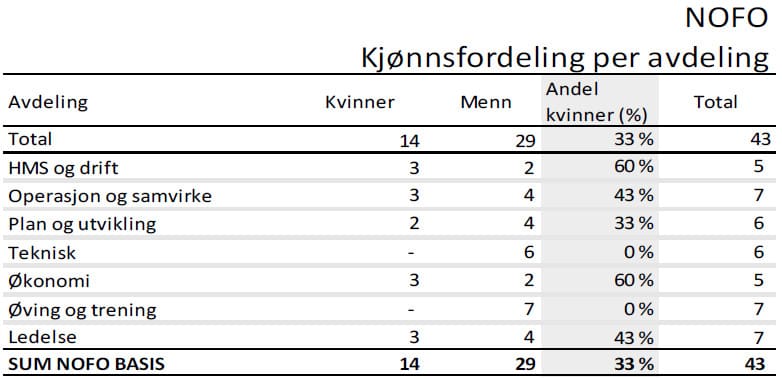
Management
NOFO’s management team consists of 7 members including the CEO. The proportion of women is 43%. This is unchanged from 2023.
Board of Directors
NOFO’s Board of Directors consists of 6 members. The proportion of women is 50%. In 2023, the proportion of women was 33%.
Age composition
NOFO has an average age of 53 years.
Part-time
As of 31.12.2024, NOFO has 110 part-time employees. These are mainly affiliated with emergency response groups (Guard Teams, Special Teams and IGSA), and have an estimated FTE percentage of 4.5%. They primarily have another main employer and participate in NOFO’s activities as part of the association’s emergency preparedness. No involuntary part-time work was registered in NOFO in 2024.
Temporary employees
NOFO does not have any temporary employees.
Taking parental leave
NOFO has no employees (full- or part-time) who have taken parental leave in 2024.
Status of work for equality and against discrimination
In preparing the report for 2024, the company, together with employee representatives, has reviewed the status of the measures identified in connection with extended reporting in 2023. The measures that were identified are:
- Salary and working conditions
All employees shall have equal opportunities for salary development - Recruitment
Good accuracy of candidates, prevent discrimination and sources of error of any kind - Opportunities to combine work and family life
NOFO facilitates as far as possible the opportunity to combine work and family life - Harassment, sexual harassment and unacceptable behavior
In our Code of Conduct, we have established zero tolerance for any form of harassment.
In 2024, NOFO revised its whistleblowing guidelines with the aim of simplifying and improving the guidelines and descriptions in the whistleblowing process.
Signature
Forus, March 20, 2005
Hilde Ådland
Chairman of the Board
Vår Energi ASA
Asle Jøssang
Deputy Chairman
Equinor Energy AS
John Gunnar Vedøy
Board member
AkerBP ASA
Lars Anders Heimdal
Deputy for Sara Zurawska Johannessen
Repsol Norge AS
Sønnøve McIvor
Deputy for Åshild Tandberg Skjærseth
OMV Norge AS
Jan Petter Wølstad
Employee representative
NOFO
Rune Martinsen
CEO
NOFO